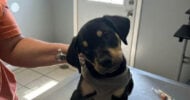
Terminology has changed over the years.
When I was in training (1996-2000), we were called physicians. Nurses were called nurses. Nurse practitioners (NPs) were called nurse practitioners. Physician assistants (PAs) were called physician assistants. Patient care assistants (PCAs) were called patient care assistants. And the suits were just that … the suits. They kept the lights on and the doors open. They didn’t provide any direct patient care. We didn’t need them to. We needed them to keep the hospital running, so that we, those of us at the bedside, could do what we do best: care for our patients.
Over the past 24 years of my career, there is no longer much distinction between physicians, nurses, NPs, PAs, PCAs, etc. We are all now called caregivers … givers of care. It’s a fitting title, especially for the nurses and PCAs who spend much more time at the bedside than us physicians. But the suits? Caregivers? I still question that. But that’s a topic for a different day.
One such person often forgotten in that grouping of caregivers is a person I’ve worked beside for much of my 23 1/2 years at our local hospital. He does not dispense medications to patients, assist them with ADLs, or clean up after them after they soil themselves. But he is as much a giver of care, even more so, than any of us caregivers combined.
He was there when I ran that code pink (pediatric code) in our ER on that adolescent girl early in my career, when my team and I performed countless chest compressions, administered every conceivable drug from not one but three crash carts (even Bretylium, yes Bretylium!), when I “busted” her, shocked her, or, more appropriately, defibrillated her 13 times with 360 joules, all in an effort to save her precious life. He was there, when I pronounced her death, when I, my ER nurses, pharmacists, ER physicians, and PCAs couldn’t contain our anger, tears, and anguish after that Code Pink. And he was there, accompanying me, when I met with her family, to tell her mother and father that their precious daughter was not coming home, but that she was going Home.
He was there when I resuscitated a toddler, barely two years old. He was there, protecting me while simultaneously consoling her mother, when I called the code, the time of death, when she, understandably so, directed all her anger and terror at me, at my ER colleagues, at us, as her baby lay there lifeless.
He was there over the years for countless patients, for those gasping their last breaths, for their grieving spouses, for their families, when no one else could console them, could care for them, when no further care could be given. He cared for them.
He was there for that young lady, the one addicted to drugs, who presented to our hospital time and again, who overdosed, who countless times cheated death. He was there for her. He never gave up on her. He counseled her and consoled her. He prayed for her. And when she was released from her local county jail, when she decided to turn her life around during her days of sobriety, when she decided to “get the hell out of Dodge,” she returned one last time to our hospital … to thank him for not giving up on her, for helping her realize that she, too, was worth it.
He was there for patients as a member of our hospital’s palliative care team; one would argue he was the most vital member. In previous years, he worked closely with home hospice staff, visiting and caring for patients and families as those terminal patients transitioned into the afterlife. Before that, he was a proud local member of our community’s firefighting and EMS crews.
He was there for the local children of Southern Ohio as he played the role of Santa Claus, along with his wife, Mrs. Claus. He provided the boisterous “ho-ho-ho’s” and, more importantly, offered hope to children who had very little to begin with.
He was there with me in the ICU for the entirety of the pandemic and beyond, when I spent the bulk of my days discussing, preparing, and consoling families for the untimely and premature deaths of our local community members. He was there, in full PPE, helping and guiding those end-of-life discussions with me, beside me. He did not work from home. He was there.
That first Christmas of the pandemic, when all of us in the intensive care unit (ICU) experienced nothing but dread, death, and suffocation when we all lost hope, he was there, along with Mrs. Claus, bearing gifts, bringing hope, and healing all our shattered souls that Christmas Eve, December 24, 2020 … just like the real Santa Claus.
And, true to form, he was there this past December, beside me, with me, that fateful day as I delivered the news to my ICU family that my job was being eliminated, that I was being let go.
He pastors a local community church when the resident pastor is not available. He has officiated weddings, funerals, and ceremonies of all kinds for church members, for non-members, for the faithful, even for those without faith, and especially for patients with no home church. If they asked, he delivered. He could not turn them away.
Before the pandemic and ever since, Chaplain Bruce and I started sharing stories of people and patients we cared for over the years. We shared the good, the bad, the ugly, and how those situations affected us, them, and their families. When the world turned upside down for two years, our stories kept us going, and we kept each other going. We both noticed then that many of our ICU family bore heavy hearts and souls too. Together, he and I concocted our own healing group, which we branded SODAS (Southern Ohio Debriefing Arts Society). As the pandemic wound down in early 2022, we invited ICU staff to the first of several SODAS meetings in a small private room at a local coffee shop. In that room, in that meeting, during breakfast, we met as a family, and we told stories, our stories, patient stories (HIPAA compliant, of course), and we healed together. He often led the discussion, broke the proverbial ice, and then staff/family members chimed in. He would then take a back seat and watch the healing process, the flood of emotions, begin. We have had several sessions since that inaugural meeting. A handful of family and friends would attend, usually six to eight people per meeting. And with each session, our fondness for each other, for our efforts, and for those patients we served only grew and helped mend our broken souls.
Later this summer, Chaplain Bruce plans to retire. I have known him and interacted with him for much of my career. I cherish our time together, our laughs and memories, and especially our shared stories. One would say he is a pillar of our community. I would argue he IS the community. And unlike today’s modern terminology, not only is he a caregiver but a healer as well. He has healed many souls. He never lost faith in his community. He often instilled faith in those who never had faith to begin with. And he has always provided hope.
Not all healers wear scrubs or lab coats, especially Chaplain Bruce—our modern-day Santa Claus.
Zoran Naumovski is a hospitalist.






















![Catching type 1 diabetes before it becomes life-threatening [PODCAST]](https://kevinmd.com/wp-content/uploads/Design-2-190x100.jpg)

![How political polarization causes real psychological trauma [PODCAST]](https://kevinmd.com/wp-content/uploads/Design-4-190x100.jpg)
